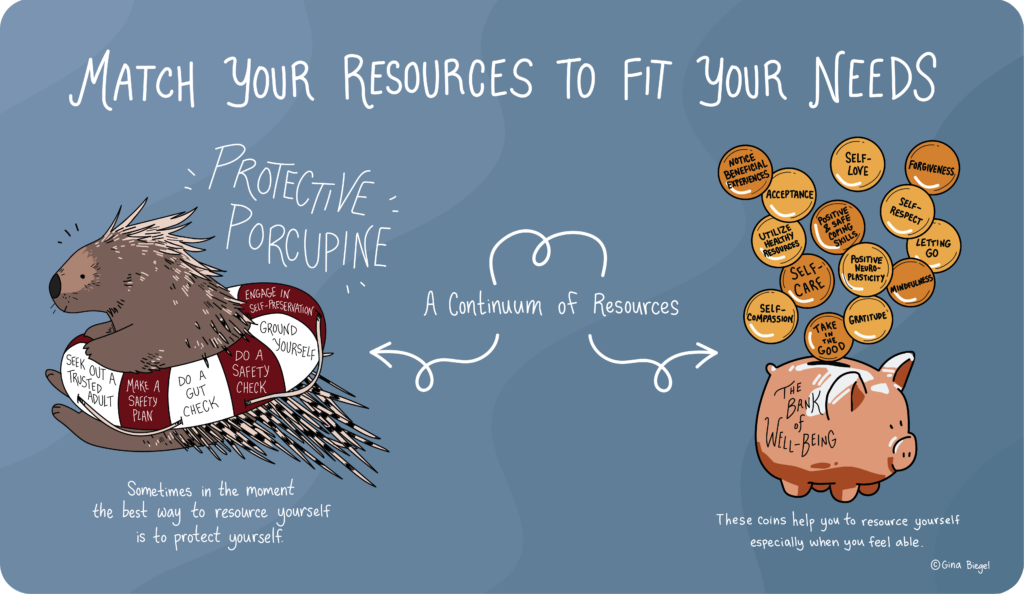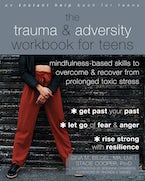By Gina Biegel, MA, LMFT, coauthor of The Trauma and Adversity Workbook for Teens
Identification, Awareness, and Discovery
The first step in trauma and adversity healing is the acknowledgement and awareness of what events in one’s life have occurred. Recovery is a process, and sometimes an arduous one. Steps in the recovery and healing journey may be slow and sloth-like at times; other times it might feel like a sprint. This healing journey may have some back steps. The aim of healing is progress, not perfection.
I want to make explicit what trauma and adversity are. So often, people use these words without explaining them. Adversity is a broad term that refers to a wide range of risk factors, circumstances, or experiences that pose a serious threat to your physical or psychological health and well-being. Trauma is the result of an overwhelming amount of stress that exceeds a person’s ability to cope with, manage, or handle it.
Impact and Effects of Adversity and Trauma
The impact of adverse circumstances and traumatic events varies from person to person. What one person finds to be traumatic might not be for another. There is no black-and-white list which provides an exclusive list of boxes to check (that would make identification much easier). When someone breaks their leg and gets a cast, people see it. Unfortunately, many adverse experiences are unseen and hidden, and their impact might take many years to come to fruition. Additionally, the impact of trauma and adversity have a lot to do with how a person perceives and appraises the circumstances as impinging or threatening to the person.
Trauma and adversity can lead to debilitating impacts—physically, mentally, emotionally, financially, spiritually, and in one’s development. People with significant trauma and adversity might not be on the same playing field as someone who hasn’t experienced trauma and adversity. What makes this more difficult is if a person is still in an environment that is currently the source of the adversity or causing the continued trauma.
A Continuum of Resources: How to Meet One’s Needs
You wouldn’t expect someone who is starting to train for a marathon to begin with the full 26.2 miles. Rather, they would begin with a manageable goal, full of incremental steps in the training process. If they have some training under their belt, going back to a shorter distance wouldn’t make sense either. Like training for a marathon, people want to meet their trauma and adversity where they are at. Some might be newer in the healing journey and recovery process, some further along. If someone is experiencing acute signs, symptoms, and suffering, they would want to focus on immediate safety and getting assistance to minimize distress. Whereas someone who has had perhaps years of therapy, or are no longer in the adverse or traumatic environment, might want to do work on themselves to better their health and wellness.
The illustration below provides some suggestions on how to meet one’s needs with where they are at using the appropriate resources. The topic areas of both of these images are explored thoroughly and in detail in The Trauma and Adversity Workbook for Teens.

How to Engage in ‘Resourcing Yourself’: Match Resources to Meet One’s Needs
Someone needs to know where they are at in their adversity and trauma journey to know where to begin. Once identified, a person can match resources with the best fit for them.
Resourcing yourself is the process of utilizing healthy and safe coping skills, engaging in self-care activities, and related tools that benefit one’s health, wellness, and well-being. Click here to download a list of twenty-five Healthy and Positive Coping Skills.
The Protective Porcupine provides concrete, immediate suggestions on the life preserver to help someone that is in imminent danger to assist with them getting and staying safe. Sometimes in the moment, the best way to “resource yourself” is to protect yourself. If you or someone you know is needing immediate resources, click here.
On the other end of the continuum is the Bank of Well-Being. Think about real-life emergencies. When people need money in an emergency, they often go to the bank and get money that they’ve saved. If someone doesn’t have the money they need, it’s difficult to deal with the emergency. Similarly, when people deal with a difficult time in their life (whether stress, a health problem, adversity, trauma, or the like) it’s hard, if not impossible, to manage when there are no savings, or resources, to pull from.
When practicing self-care, gratitude, and acceptance, for example, they’re adding more coins to their bank. These coins get stored and act as resources that can be pulled from to help people to be better able to tolerate and manage whatever difficulties life throws their way. The more coins someone puts in their bank of well-being, the more resources saved to call on in times of stress or hardship.
When people do things that are beneficial to them, they can turn to these resources to help when life is unmanageable. If people have been doing things that are to their benefit on a regular basis, the harder things are, the easier they’ll be to tolerate. The more things people can do to create positive, healthy resources for themselves, the more “coins” they add to their “bank,” and the more it can enhance overall health and well-being. The more people resource themselves, the more coins they have in their bank of well-being, and the more supported one can feel during times of stress, adversity, and trauma.
Trauma and adversity identification and recovery is a process that is possible. It takes active effort and energy to participate on the path to healing and recovering from the significant adversities and traumas that a person may have or are experiencing.
Read Part 2 here.
Gina M. Biegel, MA, LMFT, is a psychotherapist, researcher, speaker, and author specializing in mindfulness-based work with adolescents. In 2004, she founded and created the evidence-based mindfulness-based stress reduction for teens (MBSR-T) program. She is author of Take in the Good, Be Mindful and Stress Less, and The Stress Reduction Workbook for Teens.



 2024 Peace Playbook: 3 Tactics to Avoid Clashes with Your Partner
2024 Peace Playbook: 3 Tactics to Avoid Clashes with Your Partner